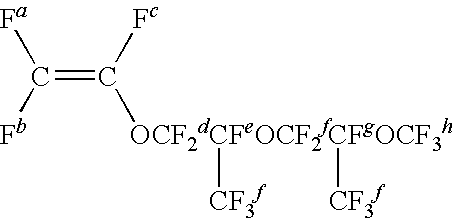Fluorine-Containing Elastomer and Composition Thereof
a technology of fluorine-containing elastomers and compositions, which is applied in the field of fluorine-containing elastomers and a composition thereof, can solve the problems of poor molding processability, deterioration of low-temperature characteristics, and often fails to meet the recent technical progress, so as to improve the resistance to fuel mixed, reduce the length of break at high temperature, and improve the solvent resistance
- Summary
- Abstract
- Description
- Claims
- Application Information
AI Technical Summary
Benefits of technology
Problems solved by technology
Method used
Image
Examples
reference example 1
[0052]36 g of cesium fluoride, 360 g of diglyme, and 4.18 kg of CF3OCF(CF3)COF were charged into a stainless steel autoclave having a capacity of 10 L, provided with a stirrer, stirred overnight, and then cooled to −10° C., and 12.0 kg of hexafluoropropene oxide was added thereto at a feed rate of 150 g / hr. After the end of addition, the mixture was further stirred for 2 hours, while keeping that temperature, and then returned to room temperature. Then, stirring was discontinued, and the mixture was allowed to stand. Then, only the fluorocarbon phase was carefully withdrawn from the lower outlet of the autoclave. 15.9 kg of the fluorocarbon phase thus obtained was analyzed by gas chromatography (GC), and found to have the following composition:
CF3O[CF(CF3)CF2O]nCF(CF3)COFnGC (%)2132745052062
[0053]1.2 kg of the resulting fluorocarbon phase and 1.2 kg of anhydrous potassium carbonate were charged into a glass reactor vessel having a capacity of 10 L, provided with a stirrer, and heate...
reference example 2
[0055]36 g of cesium fluoride, 360 g of diglyme, and 4.5 kg of CF3CF2OCF(CF3)COF were charged into a stainless steel autoclave having a capacity of 10 L, provided with a stirrer, stirred overnight, and then cooled to −10° C., and 12.0 kg of hexafluoropropene oxide was added thereto at a feed rate of 150 g / hr. After the end of addition, the mixture was further stirred for 2 hours, while keeping that temperature, and then returned to room temperature. Then, stirring was discontinued, and the mixture was allowed to stand. Then, only the fluorocarbon phase was carefully withdrawn from the lower outlet of the autoclave. 11.8 kg of the fluorocarbon phase thus obtained was analyzed by gas chromatography (GC), and found to have the following composition:
CF3CF2O[CF(CF3)CF2O]nCF(CF3)COFnGC (%)2232845151762
[0056]1.3 kg of the resulting fluorocarbon phase, and 1.3 kg of anhydrous potassium carbonate were charged into a glass reactor vessel having a capacity of 10 L, provided with a stirrer, and...
example 1
[0058]A stainless steel autoclave having a capacity of 500 ml was internally flushed with a nitrogen gas, and after the deaeration the following reaction medium were charged thereto:
Surfactant CF3CF2CF2OCF(CF3)CF2OCF(CF3)COONH430gNa2HPO4•12H2O0.5gIon-exchanged water250ml
[0059]The autoclave was again internally flushed with a nitrogen gas, and after the deaeration the following reactant materials were charged thereto.
Vinylidene fluoride [VdF]42 gPerfluoro (methyl vinyl ether) [FMVE]28 gCF2═CFO[CF2CF(CF3)O]4CF3 [MPr4VE]39 gCF2═CFO[CF2CF(CF3)O]4CF2CF3 [EPr4VE] 5 gCF2═CFOCF2CF2Br [FBrVE] 2 gICF2CF2CF2CF2I [DIOFB]0.5 g
[0060]Then, the autoclave inside temperature was adjusted to 50° C., and 0.01 g of sodium hydrogen sulfite and 0.05 g of ammonium persulfate were added thereto each as an aqueous 0.3 wt. % solution to initiate polymerization reaction. After the reaction for 2 hours, the autoclave was cooled, and the residual gas was vented therefrom, and the resulting emulsion was taken th...
PUM
| Property | Measurement | Unit |
|---|---|---|
| glass transition temperature Tg | aaaaa | aaaaa |
| temperatures | aaaaa | aaaaa |
| temperatures | aaaaa | aaaaa |
Abstract
Description
Claims
Application Information
 Login to View More
Login to View More - R&D
- Intellectual Property
- Life Sciences
- Materials
- Tech Scout
- Unparalleled Data Quality
- Higher Quality Content
- 60% Fewer Hallucinations
Browse by: Latest US Patents, China's latest patents, Technical Efficacy Thesaurus, Application Domain, Technology Topic, Popular Technical Reports.
© 2025 PatSnap. All rights reserved.Legal|Privacy policy|Modern Slavery Act Transparency Statement|Sitemap|About US| Contact US: help@patsnap.com



